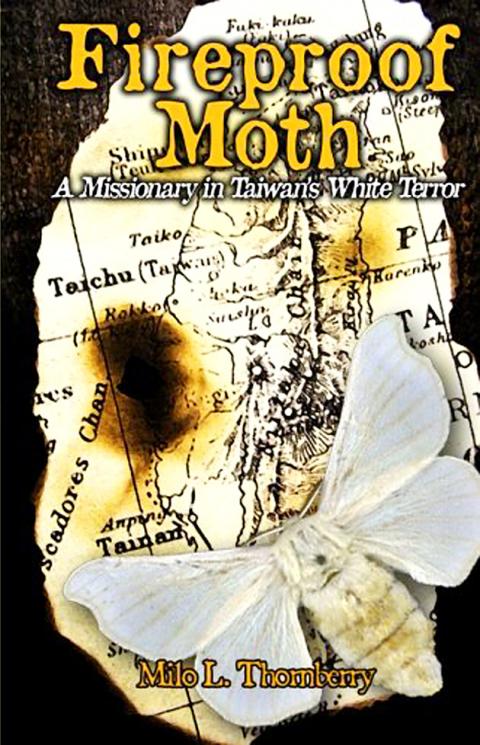Fireproof Moth is an autobiographical account of a Methodist missionary’s stay in Taiwan in the late 1960s, but it reads like a thriller.
Author Milo L. Thornberry first describes his personal journey to becoming a minister in the mid 1950s. In 1965, the Methodist Church decided to send Thornberry and his wife Judith to Taiwan, and the couple went through preparatory sessions at Drew University and Stony Point Missionary Orientation Center north of New York. During this time he read some critical works such as George Kerr’s Formosa Betrayed and Mark Mancall’s Formosa Today.
Upon arrival in Taipei on New Year’s Eve 1966 the couple settled down, started language school, and gradually came to experience the suffocating hold that the Chinese Nationalist Party (KMT) regime of Chiang Kai-shek (蔣介石) had on society in Taiwan. They also got to know Peng Ming-min (彭明敏), a professor who was under house arrest at the time for publishing a document titled A Manifesto for Self-Salvation in 1964.

The couple started to help channel support from overseas to families of political prisoners, with the help of Peng’s two courageous students, Hsieh Tsung-min (謝聰敏) and Wei Ting-chao (魏廷朝). They also began producing mimeographed information sheets to inform visiting friends and colleagues overseas about the repressive political atmosphere in the country.
Together with other foreign friends in Taiwan they approached American and European reporters and supplied background information on developments in Taiwan. Fox Butterfield of the New York Times and Selig Harrison of the Washington Post were among the reporters they communicated with.
When in September 1968 Peng told the couple that he had received indications from the Investigation Bureau of the Ministry of Justice, one of the main secret police organizations at the time, that he might have an “accident,” a plan was devised to smuggle him out of Taiwan. After more than a year of preparation the plan became a reality, and on Jan. 3, 1970, Peng left Taiwan using a doctored Japanese passport and disguised as a Japanese musician.
He made it safely to Sweden, where he received political asylum. Eventually Peng made it to the US, where he became a senior research scholar and visiting professor at the University of Michigan.
Oddly, the KMT authorities never discovered the role played by Thornberry and his wife in Peng’s escape. They surmised that he had been helped by the CIA. The matter even came up in the February 1972 discussions between then-US national security adviser Henry Kissinger and president Richard Nixon with Chinese premier Zhou Enlai (周恩來). Zhou accused the Americans of aiding Peng in his escape, but Nixon responded with indignation: “We had nothing to do with it.”
However, Taiwan’s secret police agencies kept an ever tightening watch over Milo and Judith, and on March 2, 1971 — more than a year after Peng’s escape — they were arrested and expelled from Taiwan. Selig Harrison visited them in their home while they were under house arrest and wrote a front-page article about it in the Washington Post (“Taiwan expels US missionary,” March 4, 1971).
It wasn’t until December 2003, at a reunion of human rights and democracy activists organized by the Taiwan Foundation for Democracy, that Milo and Judith — as well as the Japanese counterparts who also played a crucial role — disclosed their involvement in Peng’s escape.
The book reads like a spy thriller and fills a key void in the written history of Taiwan’s very recent transition to democracy. It is highly recommended.

This month the government ordered a one-year block of Xiaohongshu (小紅書) or Rednote, a Chinese social media platform with more than 3 million users in Taiwan. The government pointed to widespread fraud activity on the platform, along with cybersecurity failures. Officials said that they had reached out to the company and asked it to change. However, they received no response. The pro-China parties, the Chinese Nationalist Party (KMT) and Taiwan People’s Party (TPP), immediately swung into action, denouncing the ban as an attack on free speech. This “free speech” claim was then echoed by the People’s Republic of China (PRC),

Exceptions to the rule are sometimes revealing. For a brief few years, there was an emerging ideological split between the Democratic Progressive Party (DPP) and Chinese Nationalist Party (KMT) that appeared to be pushing the DPP in a direction that would be considered more liberal, and the KMT more conservative. In the previous column, “The KMT-DPP’s bureaucrat-led developmental state” (Dec. 11, page 12), we examined how Taiwan’s democratic system developed, and how both the two main parties largely accepted a similar consensus on how Taiwan should be run domestically and did not split along the left-right lines more familiar in

Many people in Taiwan first learned about universal basic income (UBI) — the idea that the government should provide regular, no-strings-attached payments to each citizen — in 2019. While seeking the Democratic nomination for the 2020 US presidential election, Andrew Yang, a politician of Taiwanese descent, said that, if elected, he’d institute a UBI of US$1,000 per month to “get the economic boot off of people’s throats, allowing them to lift their heads up, breathe, and get excited for the future.” His campaign petered out, but the concept of UBI hasn’t gone away. Throughout the industrialized world, there are fears that

Most heroes are remembered for the battles they fought. Taiwan’s Black Bat Squadron is remembered for flying into Chinese airspace 838 times between 1953 and 1967, and for the 148 men whose sacrifice bought the intelligence that kept Taiwan secure. Two-thirds of the squadron died carrying out missions most people wouldn’t learn about for another 40 years. The squadron lost 15 aircraft and 148 crew members over those 14 years, making it the deadliest unit in Taiwan’s military history by casualty rate. They flew at night, often at low altitudes, straight into some of the most heavily defended airspace in Asia.